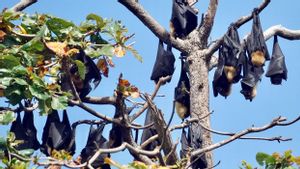JAKARTA - Currently, India, especially in the state of Kerala, is battling an outbreak of the Nipah virus which killed two of its citizens, a 49-year-old man from Maruthonkara Village, on August 30 2023, and a 40-year-old man from Ayancheru Kerala, on September 11, 2023.
Before they died, both of them were sick with flu-like symptoms, including headache, fever, cough, acute respiratory problems, and seizures. Medical personnel then carried out tests for the Nipah virus and both were confirmed to have died due to being infected with the virus.
So, what exactly is the Nipah virus, how is it transmitted, the symptoms that arise, and steps to prevent it?
Adapted from the Control Disease Center (CDC) page, Monday, September 18, the Nipah virus (NiV) was first discovered in 1999 after an outbreak of disease in pigs and humans in Malaysia and Singapore. This outbreak resulted in nearly 300 cases in humans with a death toll of more than 100 people. As well as having a large economic impact because more than 1 million pigs were killed to help control the outbreak.

Although there have been no more NiV outbreaks in Malaysia and Singapore since 1999, it turns out that this outbreak has been recorded almost every year in several regions of Asia since then, especially in Bangladesh and India. The virus has been shown to spread from person to person, raising concerns about the potential for NiV to cause a global pandemic.
NiV is a member of the Paramyxoviridae family, genus Henipavirus. This is a zoonotic virus, meaning it initially spread between animals and humans. The NiV reservoir host animal is the fruit bat (genus Pteropus), which is also known as the Flying Fox.
Infected fruit bats can spread the disease to humans or other animals, such as pigs. People can become infected if they come into close contact with infected animals or their body fluids (such as saliva or urine). This initial spread from animals to humans is known as a spillover event. Once this virus spreads to humans, person-to-person spread of NiV may also occur.
Symptoms of NiV infection range from mild to severe. Symptoms of the Nipah virus usually appear within 4-14 days after exposure to the virus. This disease initially appears as fever and headache for 3-14 days. And it's often accompanied by signs of respiratory illness, such as coughing, sore throat and difficulty breathing.
A phase of brain swelling (encephalitis) may occur, with symptoms including drowsiness, disorientation, and mental confusion, which can progress rapidly to coma within 24-48 hours.
اقرأ أيضا:
The percentage of deaths due to this virus is quite large, namely around 40-75 percent. Long-term side effects have also been found in survivors of Nipah virus infection, including persistent seizures and personality changes.
Infections that cause symptoms and sometimes death long after exposure (known as inactive or latent infections) have also been reported months or even years after exposure.
To prevent this, everyone must take steps such as:
- Get into the habit of washing your hands regularly with soap and water
- Avoid contact with sick bats or pigs
- Avoid areas where bats usually roost
- Avoid eating or drinking products that could be contaminated by bats, such as raw date sap, unripe fruit, or fruit that has fallen on the ground
- Avoid contact with the blood or body fluids of people known to be infected with NiV
Even though this is currently happening in India, it does not rule out the possibility of this disease developing in other countries. Geographical location, such as the area where fruit bats live, has a big influence. Fruit bats are currently found in Cambodia, Indonesia, Madagascar, the Philippines and Thailand.
People living in or visiting these areas should consider the same precautions as those living in areas where outbreaks have occurred.
The English, Chinese, Japanese, Arabic, and French versions are automatically generated by the AI. So there may still be inaccuracies in translating, please always see Indonesian as our main language. (system supported by DigitalSiber.id)













